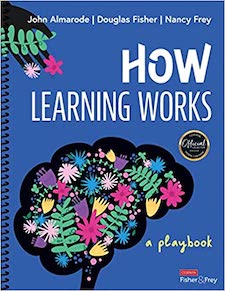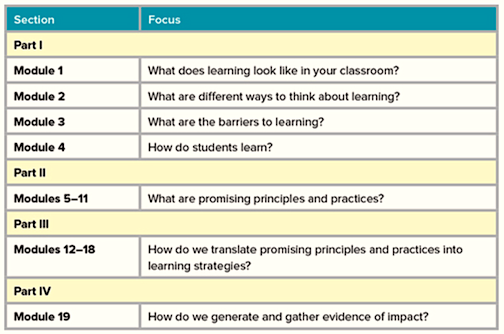A Deep Dive into How Learning Works
How Learning Works: A Playbook
By John Almarode, Douglas Fisher and Nancy Frey
(Corwin Press, 2022 – Learn more)
Reviewed by Anne Anderson

Be prepared to do some heavy duty thinking, reflecting, and responding with this text. You will also want your personal “write-on” copy of How Learning Works. Throughout the spiral-bound book, you will respond, reflect, describe, explain, and show evidence of your own learning.
The authors may be familiar to educators who have followed the work of John Hattie and his colleagues, including Almarode, Fisher and Frey. Corwin’s collection of playbooks devoted to various aspects of this work would fill a bookshelf!
On page 5 you will find this overview of the How Learning Works playbook.
Within these modules readers find tools, prompts, and activities to utilize a variety of instructional practices in their classrooms. Throughout the book the authors have included QR codes for video clips, templates, and additional resources. The playbook, along with its accompanying resources, is an excellent choice for administrators and instructional coaches to use in PLCs.

The modules in Part II focus on these promising principles: motivation, attention, elaborate encoding, retrieval and practice, cognitive load, productive struggle, and feedback. Each chapter begins with an explanation of the promising principle and concludes with a check for understanding.
My key takeaways from Part II
Module 6, Promising Principle 2: Attention
“Attention is our capacity for identifying, selecting, and focusing our cognitive resources on specific stimuli.” (p.56) In this module, readers are invited to list specific influences that affect their students’ attention. Most teachers will find there is not enough space for this list!
Following that is a discussion of three factors that influence attention:
- Prior Knowledge and Learning
- Deep Motivation
- Awareness/Attention/Engagement
The authors discuss how this principle or practice might look in a classroom. Then they suggest four practices from the research on attention to help address the challenges in today’s classrooms. The reader is challenged to focus on improving attentiveness in their classroom.
Module 11, Promising Principle 7: Feedback
“Feedback is the glue that holds the acquisition, consolidation, and storage of learning together.” (p.110)
The giving and receiving of feedback has the potential to propel learning forward for all students. The authors reference John Hattie’s 2012 research suggesting that teachers address these three questions:
- Where are we going?
- How are we going?
- Where do we go next?
The authors share examples of learning intentions and success criteria from mathematics, science, English language arts, and social studies. After completing the accompanying chart describing the focus of this feedback, readers have insight into what is needed to move learning forward. The authors remind readers that feedback “needs to come at the right time, personalized for the specific learner and their learning, and focus on moving learning forward.” (p.114)
What you’ll find in Part III
The modules in Part III address these explicit strategies: goal setting, integrating prior knowledge, summarizing, mapping, self-testing, and elaborate interrogation.
Learning Strategy 5: Self-Testing
“Self-testing occurs when learners respond to low-stakes practice questions about previously learned material.” (p.180) Readers are invited to complete a chart describing how self-testing benefits motivation, attention, elaborate encoding, retrieval and practice, cognitive load, productive struggle, and feedback. As the authors continue to lay the foundation for self-testing, a graphic (summarized here) shows the process.
➡︎ Learners must acquire a tool kit and collect resources to support their self-testing.
➡︎ Learners must align the tools and resources they select with the specific learning outcomes communicated through the learning intention and success criteria.
➡︎ Learners must know where to go to give and receive feedback.
What then follows is an explanation of how this learning strategy might be presented in the classroom.
The final module, Generating and Gathering Evidence, guides readers in evaluating the impact of the science of learning and these strategies in their classrooms. This evidence “guides us in making decisions about what happens next in our teaching and their learning.” (p.215)
Gaining insights into your students’ learning
How Learning Works: A Playbook provides educators with learning strategies our students need to become independent learners. Yes, you will have to make adaptations to these practices. Yes, you have to study the evidence to check that learning has occurred. Some days – some weeks – it may be slow going, but keep on keeping on. “When we gather evidence through seeing and listening, we gain insight into learners’ understanding, dispositions, and motivations.” (p.215)
Anne Anderson always knew she wanted to be a teacher. She graduated from East Texas Baptist University with an English major and History minor and did graduate work at Louisiana State University and Louisiana Tech University. After teaching 8th graders for 24 years, Anne served as a content coach. Since retiring in 2011, Anne has worked as an educational consultant, presenting at national conferences and onsite trainings for public and private schools.
Calendar Celebrations: September, October, November is part of Anne Anderson’s trilogy on resources for months of the school year. (For MiddleWeb she wrote about selected fall celebrations here, about spring here and about winter here.) Anne has also published articles in IDEAS Plus and Voices from the Middle, publications of the National Council of Teachers of English. She is a frequent reviewer of professional books for MiddleWeb.com.



































